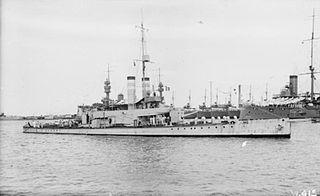USS Yorktown may refer to:

The USS Panay incident on December 12, 1937, was a Japanese bombing attack on the U.S. Navy river gunboat Panay and three Standard Oil Company tankers on the Yangtze River. They strafed survivors in the water. The boats were rescuing U.S. and Chinese civilians fleeing from Japanese invaders attacking Nanking, China. Japan and the United States were not at war at the time. Public outrage was loud in the U.S., but both sides were conciliatory and quickly settled the dispute. The Japanese claimed that they did not see the U.S. flags painted on the deck of the gunboat. Tokyo officially apologized, and paid a cash indemnity. The settlement mollified some of the U.S. anger, and newspapers called the matter closed.
USS Suwanee or Suwannee may refer to one of these United States Navy ships:

The Asiatic Squadron was a squadron of United States Navy warships stationed in East Asia during the latter half of the 19th century. It was created in 1868 when the East India Squadron was disbanded. Vessels of the squadron were primarily involved in matters relating to American commerce with China and Japan, though it participated in several conflicts over 34 years of service until becoming the Asiatic Fleet in 1902.

A river gunboat is a type of gunboat adapted for river operations. River gunboats required shallow draft for river navigation. They would be armed with relatively small caliber cannons, or a mix of cannons and machine guns. If they carried more than one cannon, one might be a howitzer, for shore bombardment. They were usually not armoured. The fictional USS San Pablo described in Richard McKenna's The Sand Pebbles is an example of this class of vessel, serving on the US Navy's Yangtze Patrol. Stronger river warships with larger guns were river monitors.

The second USS Panay (PR–5) of the United States Navy was a river gunboat that served on the Yangtze Patrol in China until sunk by Japanese aircraft on 12 December 1937 on the Yangtze River.

The Yangtze Patrol, also known as the Yangtze River Patrol Force, Yangtze River Patrol, YangPat and ComYangPat, was a prolonged naval operation from 1854–1949 to protect American interests in the Yangtze River's treaty ports. The Yangtze Patrol also patrolled the coastal waters of China where they protected U.S. citizens, their property, and Christian missionaries.

HMS Ladybird was an Insect-class gunboat of the Royal Navy, launched in 1916. This class are also referred to as "large China gunboats". Originally built to patrol the River Danube during the First World War, she sailed for China from Malta in February 1927 to serve on the Yangtze River.
The first USS Mariveles was a gunboat in the United States Navy during the Spanish–American War.

USS Wilson (DD-408), was a Benham-class destroyer of the United States Navy.

USS Tutuila (PR-4) was a gunboat in the service of the United States Navy from 1928, until her transfer to China, under lend-lease in 1942.

John Henry Lang (1899–1970) was an American who served with the Canadian Army in World War I and then with the United States Navy through World War II and the end of his career. He earned military awards and honors for heroic service from the United Kingdom, the United States, and Japan in the first half of the twentieth century.

The Insect-class gunboats were a class of small, but well-armed Royal Navy ships designed for use in shallow rivers or inshore. They were intended for use on the Danube against Austria-Hungary. The first four ships—Gnat, Mantis, Moth and Tarantula—were first employed during the Mesopotamian Campaign of the First World War on the Euphrates and Tigris rivers.

USS Finch (AM-9) was a Lapwing-class minesweeper acquired by the U.S. Navy for the dangerous task of removing mines from minefields laid in the water to prevent ships from passing. Finch was named for the finch, and is strictly speaking the only U.S. vessel named for such.

The Commander-in-Chief, China was the admiral in command of what was usually known as the China Station, at once both a British Royal Navy naval formation and its admiral in command. It was created in 1865 and deactivated in 1941.

The first USS Oahu (PR-6), a Yangtze River gunboat, was laid down by Kiangnan Dock and Engineering Works, Shanghai, China, 18 December 1926; launched as PG–46 on 26 November 1927; sponsored by Mrs. Bryson Bruce, wife of Comdr. Bruce; and commissioned 22 October 1928, Lt. Comdr. A. C. Thomas in command.

USS Samar (PG-41) was a gunboat of the United States Navy. She was initially built for the Spanish Navy, but was captured during the Spanish–American War and taken into service with the US Navy. Samar had two sister-ships which also served in the US Navy, USS Pampanga (PG-39) and USS Paragua.
USS Midway (AG-41) – later renamed as USS Panay (AG-41) -- was a commercial cargo ship leased by the U.S. Navy during World War II. She was used by the Navy as a cargo ship and as a troop transport in the North Pacific Ocean. She was returned to her owner at war’s end.

After thousands of years of junk and sampan traffic on the Yangtze River (Jiang), river steamers were introduced by Europeans during the mid- to late-nineteenth century. The age of the steamer lasted nearly 150 years—from 1835 to 1980—and had lasting impacts on China, where river trade was essential to the economy due to the poor road network and few railways.
This page is based on this
Wikipedia article Text is available under the
CC BY-SA 4.0 license; additional terms may apply.
Images, videos and audio are available under their respective licenses.












